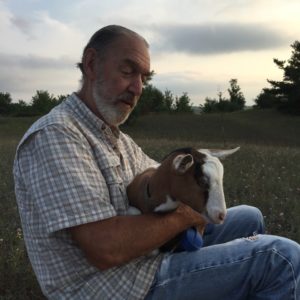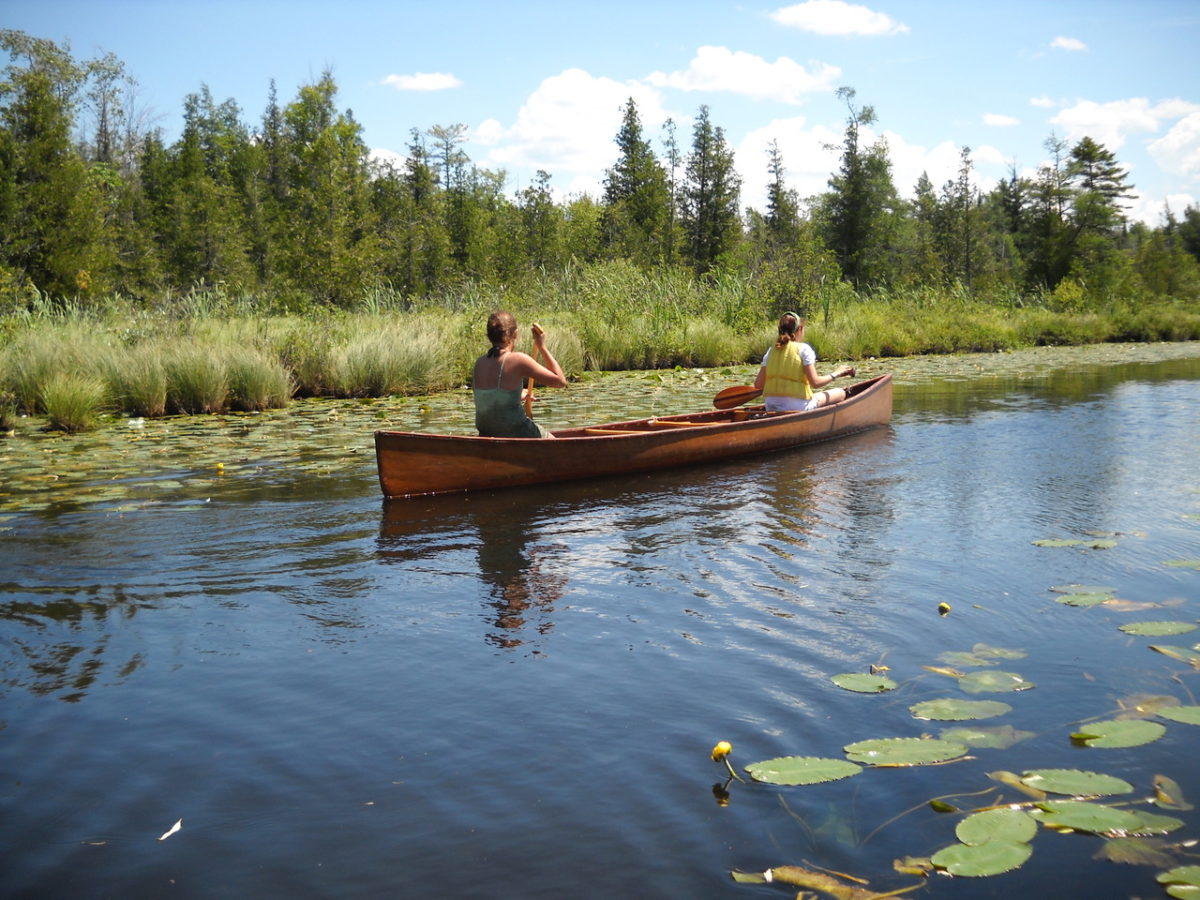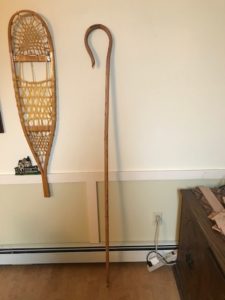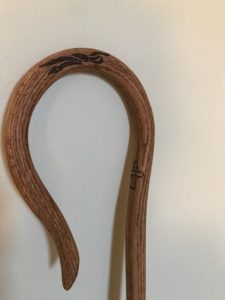Dick Flowers and his spouse Mary Buschell are goat herders and cheesemakers. They live in Maple City, Michigan on their farm, Spruce Hill.
Dick was one of Bonnie’s earliest paddling mentors. More than 22 years ago he made her first wooden kayak paddle. Bonnie asked him to create her crozier because of their long friendship, his love for all things outside and his deep roots in Michigan.
Her traveling crozier will be adorned with a wild goose and Celtic knots. The following sermon gives you an idea why both Bonnie and Dick thought it would be very important to have a wild goose to travel with her for every visitation.
Scroll to the end of this post to find photos of the crozier as it was being crafted.
The Wild Goose & the Rich Young Man
October 11, 2009
Bonnie A. Perry
I propose to show—that we just don’t own it so that those hearing this sermon will relax into knowing its not about what we do and what we have but rather about who we are in relation to Jesus Christ.
Good Morning!
So, it turns out—its not ours and it never will be.
And I’m sticking with that.
The rich young man-earnest, faithful, pragmatic. He says to Jesus, “Good teacher, what must I do to inherit eternal life?” What’s it gonna take for me to be saved? Jesus replies, “You know the deal. Keep the commandments—don’t commit adultery, don’t steal, don’t lie, keep the Sabbath, don’t defraud, honor your mother and your father.”
You can see it in his eye, how his intent stare relaxes. And you can hear it in his voice, the urgency abates. “Hey, hey,” the man is thinking, “I may be okay with this.”
“Good teacher I have done all of that since I was a child. I have done just that.” And you know he is smiling now, shaking his head. He doesn’t have to hunt this one down. He doesn’t have to plot and plan, practice and rehearse.
His wardrobe is fine. He’s okay. He’s gonna inherit eternal life because it requires nothing more than that which he’s been doing all along. .All of that knowledge flies across the synapses of his brain and endorphins of well-being flood the capillaries of his heart.
He is flush—he is good. And then… And then….
Jesus says, looking at him and loving him, “There’s just one thing—go, sell what you own and give the money to the poor, and you will have treasure in heaven; then come follow me.”
“Let it all go. Give it away, sell it at a loss. Give your money to the fellow who is selling Streetwise and then come and follow me.”
His breath quickens, his pupils dilate, his skin gets a little clammy. “But that’s what I have. But that’s who I am, it’s how I know I’m okay. Letting go of that is separating the marrow from the bone. You can do it, but you can’t stand up after.
So being the pragmatist, our man, the one I bear the most resemblance to of all the gospel characters—our man—my man–your man—turns and walks away. Because that’s just not gonna happen. He’s a pragmatist and what Jesus has just said is not so practical. Metaphor maybe, hyperbole perhaps, poetic license, for sure. But for real? How will he survive? How will he know who he is if he doesn’t have those things that assure him that he matters?
This past summer, amid my kayaking travels, I did something different. I branched out. I got serious about learning to paddle a canoe. Something I had done little to none of before this past May. Certainly, I had suffered through high school river trips in ungainly, wallowing, aluminum workhorses, plodding down algae-filled rivers, but never had I been serious about a canoe.
But, because the British Canoe Union has now decreed that people who teach kayaking must also be proficient in canoeing, I set aside some time to discern some of the basics. A dear, dear friend of mine who lives in the northern part of Michigan is a fabulous canoeist.
 So, I called him and asked if he’d share some of his skills with me. So, for four wonderful days in July, Dick came home early from work and took me paddling every afternoon for four or five hours.
So, I called him and asked if he’d share some of his skills with me. So, for four wonderful days in July, Dick came home early from work and took me paddling every afternoon for four or five hours.
We each were in our own canoe. Solo—next to one another in beautiful wooden wonders that he had built.
He taught me the j-stroke, the c-stroke, the Canadian, the Indian, and a variety of prys and draws. And eventually I could make my boat go forward, straight or turn, paddling all on one side.
Quietly, we would go around the lakes, the zen of paddling filling my body.
On our last day, we went up and down a narrow slow-moving river with many bends and turns. As we unloaded our boats and carried them on our shoulders to the rivers’ edge, we saw a Canadian goose that looked to be ill.
It didn’t move at all when we walked past it with the canoes. But then when we pushed the boats into the stream, the Goose honked, flapped its wings and got in the river right behind our boats.
Off we went, slowly paddling down the river, around the corners, into the Lilly pads. I went into the Lilly pads— Dick just went around the corners. And the goose followed.
For an hour and a half, the Goose followed. Pausing when we paused, waiting patiently when I needed to back up, turn around and get out the weeds. Sitting behind me, giving me a wide berth in those instances, because it was clear to both of us that I was something of a menace on the water.
When we reached our mid-point, as we paused to rest, our Goose, because I had come to think of it as ours, treaded water in between the two of us, duck-diving periodically to catch a minnow passing by.
We turned around and headed back upstream, and so did our Goose. But this time—it was paddling against the current, and we were able to go faster than it was.
At one point we went around the bend in the river—out of its eyesight. And it squawked and honked loudly, flapped its wings, flew over the bend and landed four feet behind us.
Shaking its bill as if to say, “Hey—I couldn’t see you anymore. Don’t get too far away!”
All the while Dick and I kept marveling because we’d never seen anything like this before. For another hour and a half, it followed us back to the start, paddling along, always staying within four feet of us.
When we landed, it climbed back up on shore and resumed the perch it had when we arrived.
Meanwhile, I’d been thinking. Dick has a farm with a horse, a pony, a mule, goats, turkeys, and more to the point 17 ducks.
I said, “Dick we have to take it home with us. That Goose likes us. It needs us. What’s it gonna do without us? We have a towel in the truck, I can wrap it and hold it in my lap. And then it can be with the ducks in the pen. It would be there—we’d know where it was.”
Dick, who is much smarter than me, just said, “Bonnie, I am not taking a wild goose home in the cab of my truck. If it wants to come visit, it can fly home behind us.”
Then it came to me. In the Celtic tradition, the Holy Spirit is portrayed not as a passive cooing dove, but as a loud, honking, squawking wild goose. Present in our lives, following close by, but never ever under our control.
It was then that it became clear that I and the Rich Young man have a lot in common. Getting confused with what’s mine, what’s God’s. What’s in our control and what’s on loan.
What I think I, perhaps you, and the rich young man need to know is, It’s not ours—it never was. At its very best, it is on some long-term intergalactic loan.
We can’t hold it, trap it, pen it up or buy it. Because it’s not ours and it never was. But God like that honking goose, diligently paddling after us, is there—and always will be.
That’s it. Until we meet the Goose on its own terms, we will never fully comprehend the beauty of this life and our role in this world.
Paddle slowly take it all in. Be the reliable, gracious steward, but don’t try to take it home—because its not ours and it never will be.
Thanks be to God.
Amen.


 So, I called him and asked if he’d share some of his skills with me. So, for four wonderful days in July, Dick came home early from work and took me paddling every afternoon for four or five hours.
So, I called him and asked if he’d share some of his skills with me. So, for four wonderful days in July, Dick came home early from work and took me paddling every afternoon for four or five hours.
